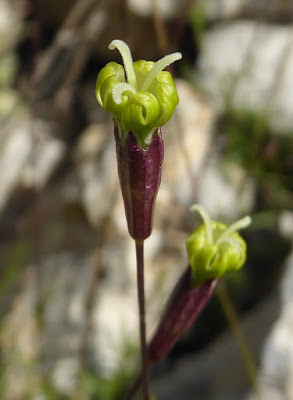I thought of subtitling this post 'Getting High on Parnassos', for in this set of pictures, we are above the treeline, on the beautiful limestone slopes, rock walls and screes of the mountain. Although the skiing industry has permanently scarred some areas with its sterile steelwork and ugly blocks of concrete, much of Parnassos remains relatively unscathed and a magnificent spring and summer flora blooms. For some reason, up above the treeline, rummaging around on rocky scree is where I seem to be happiest!
 |
| Botany with a view! Most of us made a slow but steady walk up to the bottom of the snowline, where the real gems of spring are just poking out from the browned patches of grass. |
 |
| Although its flowers are not showy, the little tufts of Silene parnassica were lovely to find and grow just above the treeline and close to the roadside in places. Despite its name, this species is quite widespread in the southern Balkans and parts of Italy. |
 |
| The yarrows include many species that are popular as garden plants for their long-lasting flowers and also for their intricate leaves. We were too early for the flowers, but the woolly leaves of Achillea fraasii were in evidence during our visit. |
 |
| One way to conserve moisture in the exposed climate of Mount Parnassos is to have lots of hairs, which will provide a more comfortable microclimate around the plant. This is shown nicely by the scruffy heads of Pilosella cymosa - one of the mouse-ear hawkweeds. |
 |
| The subtle flower spikes of the endemic Corydalis blanda ssp. parnassica were a favourite with the group. |
 |
| Crocuses are highly popular as cheerful garden plants and it's always a treat to come across them growing in the wild. Greece and Turkey together form the most important region for this genus,with many species restricted to single mountains. On Parnassos, Crocus veluchensis forms pale lilac patches below the snowline. |
 |
| Buttercups can be a difficult group to identify to species, but the strangely-shaped leaves of Ranunculus brevifolius make it an easily recognisable plant as it pokes through the stones on the scree slopes. |
 |
| Saxifrages are always popular and this one put me through my paces! I spotted the brilliant yellow flowers of Saxifraga sibthorpii through binoculars, peeping out from shady hollows on a vertical rock face above the lower snow slopes. A lot of puffing and panting got me up there to enjoy the orange freckles inside. |
 |
| David was really pleased that we found this one - even if we did struggle up to the higher slopes and then find it right beside our picnic spot later on! The louseworts are a widespread group of hemiparasites and always worth hunting down. This one is Pedicularis graeca, a gem of the Greek mountains. |
 |
| Geranium macrostylum is sometimes grown in gardens, but looks so much better in its natural habitat! |
 |
| I posted one of the more showy mulleins in an earlier post, but this one is much more subtle. Verbascum epixanthinum with its single spike of flowers atop yellow-green, furry leaves brightened up the trackside near our lunch stop. |
 |
| Yes, even grasses are worth a look on Parnassos! The tight, purple-tinged heads of Phleum alpinum are a common sight on the mountainsides. |
 |
| Viola graeca is a very variable species that can be found on a number of Greek mountains above the treeline, as well as on Mt Gargano in Italy. |
 |
| A last-minute find after lunch before it was time to head down the mountain was this single plant of Astragalus apollineus. This species grows above 1700m on just three mountains in Greece. |


















No comments:
Post a Comment